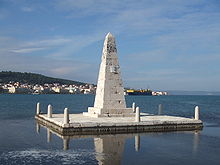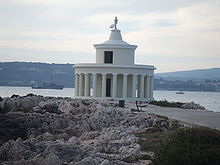Argostoli
|
Argostoli parish Δημοτική Ενότητα Αργοστολίου (Αργοστόλι) |
||
|---|---|---|
|
|
||
| Basic data | ||
| State : |
|
|
| Region : |
Ionian islands
|
|
| Regional District : | Kefallinia | |
| Municipality : | Kefalonia | |
| Geographic coordinates : | 38 ° 10 ′ N , 20 ° 29 ′ E | |
| Height above d. M .: | 81 m (average) |
|
| Area : | 155.025 km² | |
| Residents : | 13,237 (2011) | |
| Population density : | 85.4 inhabitants / km² | |
| Code No .: | 350101 | |
| Structure: |
1 city district 10 local communities |
|
| Location in the municipality of Kefalonia and in the regional unit of Kefallinia | ||
Argostoli ( modern Greek Αργοστόλι ( n. Sg. ), Katharevousa Αργοστόλιον) is the capital of the island of Kefalonia . The city was largely destroyed by an earthquake in 1953. The main road is not at the harbor, but runs parallel to the harbor quay about 150 m away. Almost all of the major sights are located on the Lithostroto ('Paved') promenade . In the last few years there have been increasing efforts to establish Hafenstrasse as a second promenade. For this purpose an avenue of palm trees was laid out.
The municipality (dimos) Argostoli was created in 1912, enlarged in 1997 by the incorporation of nearby towns such as Lassi and Peratata, and with the administrative reform in 2010 it became part of the newly created municipality of Kefalonia , in which it has since formed a municipality and the administrative center. The core city of Argostoli itself had 10,362 inhabitants in 2011.
history
At the southern end of the Gulf of Argostoli was the ancient city of Krane. Due to the risk of epidemics, it was abandoned and the new town of Argostoli was founded in its current location in 1757. Andrea da Mosto had already spoken out in 1627 in favor of founding a new island capital at this point. The main argument was the better protected natural harbor in contrast to the previous capital Lixouri .
The British island governor Charles James Napier had a wooden bridge built over the Gulf of Argostoli by the Swiss engineer Charles de Bosset in 1813 , which was replaced by a stone one 26 years later. An obelisk on the bridge commemorates the British administration. In 1829 the classical lighthouse Agios Theodoros was built. After the earthquake in 1953, it was rebuilt using the old column drums. In 1915 Great Britain seriously considered exchanging the island of Cyprus for the right to use the port of Argostoli.
Argostoli was bombed in 1943 and there was a major earthquake in 1953. Nevertheless, the appearance of the city has largely been preserved, not least because, contrary to the advice of city planners, the floor plan was not changed. In 1985 the clock tower on the Lithostroto, the city's landmark, was reconstructed with original parts.
Culture and museums
Like all larger cities in the Ionian Islands, Argostoli has a rich cultural offer. There is a philharmonic hall and the O Kefalos theater . In summer, open-air events take place on Vallianos-Platz, to which foreign groups and ensembles are invited.
There is also the Korgialenios library (library and local history museum), the Cosmetatos Foundation (a private museum on the city's history and operator of a botanical garden), an archaeological museum and a small museum of the Acqui division .
Livathos

The Livathos is the southern hinterland of Argostoli. It includes around 25 villages and is mainly characterized by cypress, olive and pine groves.
South of Argostoli is the village of Agios Georgios and the fortress of the same name. The citadel was the seat of the Count of Kefalonia from 1262. The Turks later entrenched themselves in the fortress, in 1499 the Venetians (supported by Spanish troops) conquered the fortress after a two-month siege and ended the brief Turkish rule.
In Metaxata, Lord Byron prepared for his participation in the Greek struggle for freedom . This is where his work Don Juan originated . The villa he lived in was destroyed in the earthquake. The village is next to the Koukoumelata, which was rebuilt by Vergotis, the home of numerous Kefalonian shipping companies . The lush vegetation of the village of Lourdata can be explored via a designated hiking trail run by the Archipelagos Association. The circular route begins at the Platia, the village square, and takes about two and a half hours.
Infrastructure
In addition to the port with ferry connections to Lixouri and the mainland, Argostoli has an airport with scheduled connections to Athens and Zakynthos as well as charter flights in summer.
The technical college TEI Ionion Nison is based on Argostoli. There is also a conservatory, a marine college, a hospital and a district court.
Population development
In 1981 the core city of Argostoli still had 7,164 inhabitants. This number fell slightly to 6,815 by 1991 and then rose to 9,522 by 2001. The population of the entire municipality rose from 9,918 (1991) to 12,589 (2001).
Events
On his way to Italy, the apostle Paul is said to have stopped in the Gulf of Argostoli; it was previously believed to have been Malta. The EC foreign ministers met in 1986 in Argostoli, where the 1992 Balkan Badminton Championship also took place. Argostoli is also the location of the Hollywood film Corelli's Mandolin . In 2008 the World Weightlifting Championships took place in Argostoli.
sons and daughters of the town
- Marinos Korgialenios (1830–1910), patron
- Spyridon Vikatos (1878–1960), painter
- Christian Zervos (1889–1970), art collector and publisher
- Renée Kahane (1907–2002), Romanist
- Gerasimos Arsenis (1931–2016), politician
- Antonis Tritsis (1937–1992), architect and mayor of Athens
Argostoli in literature
- Otto Flake : Fortunat, a novel in two books . Scene in the city prison, from p. 300. S. Mohn, 1960.
- Karl Werner Maximilian Wiebel: The island of Kephalonia and the sea mills of Argostoli. Attempt to solve this geophysical riddle . Hamburg 1873. ( digitized version of the British Library)
Twin cities
There are city partnerships with the following cities:
Web links
Individual evidence
- ↑ a b Results of the 2011 census at the National Statistical Service of Greece (ΕΛ.ΣΤΑΤ) ( Memento from June 27, 2015 in the Internet Archive ) (Excel document, 2.6 MB)
- ↑ History in Science and Education From Association of History Teachers Germany, E. Klett, 1950. S. 605



